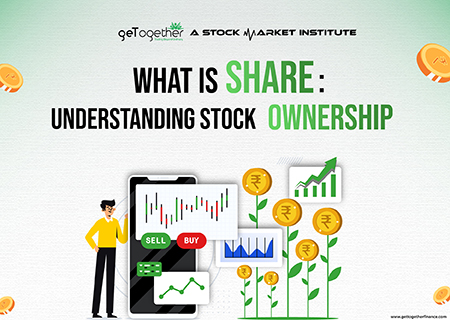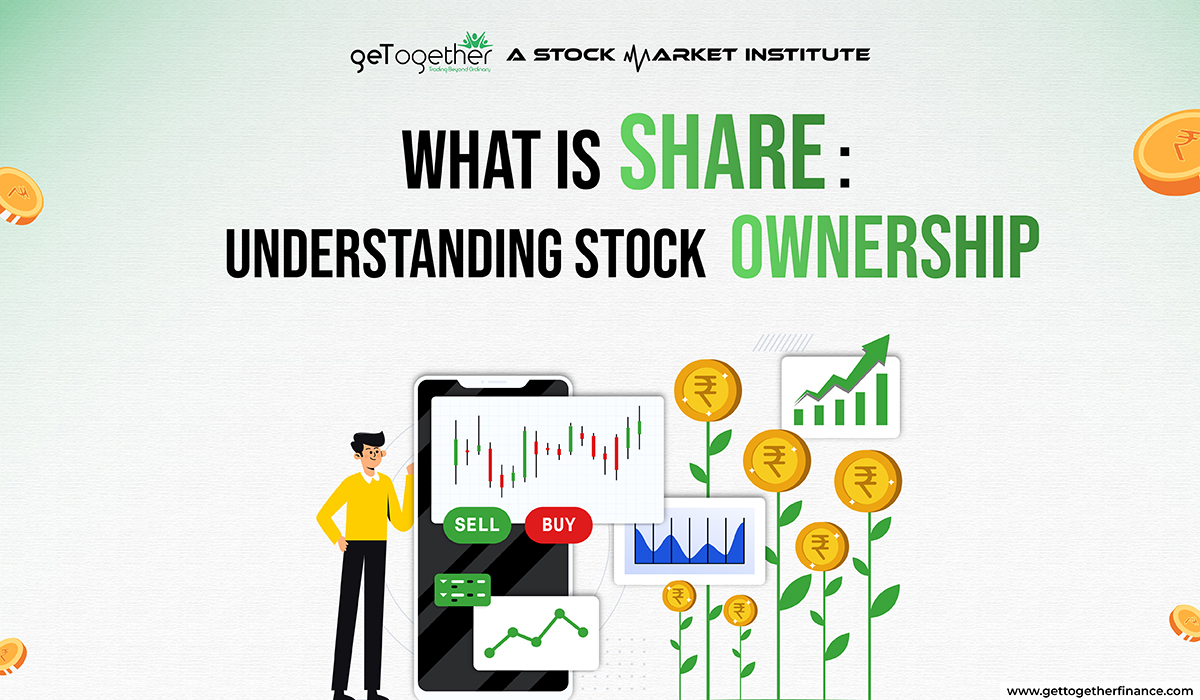What are Shares: Understanding Stock Ownership
- by GTF


Favourable economic conditions, greater focus on wealth creation among millennials, and rising awareness about the long-term benefits of investing. All these factors have boosted retail participation in the Indian bourses.
So much that new demat accounts hit a record-high 3 million in July 2023. Thanks to the upbeat market sentiment, India now houses an all-time high of 123.50 million demat account holders.
Over the past few months, the stock market has dominated morning news stories. Some of the world’s prominent investors have been singing praises about investment in stocks. Betting wisely on stocks of valuable or fundamentally strong companies helps you build long-term wealth and meet financial goals. If these facts and figures have convinced you enough to wonder “what is share,” here is a guide to help you.
What is Share?

A share is a unit representing partial ownership in a company. When a public organisation wants to raise capital, it can sell its shares to investors, who then become the equity shareholders in the business.
The company can use the capital generated to expand its business, find its operations, and perform mergers & acquisitions (M&A). At the same time, shareholders are entitled to a fraction of the organization’s assets.
Types of Shares
Shares contain two primary categories – equity and preference.
What is Equity Share?
Equity shares are the most popular types of shares that companies offer. Also called ordinary or common shares, they are transferable and are actively traded on stock exchanges. As an equity shareholder, you have the right to get dividends as well as voting rights on distinguishing corporate matters.
That said, these payouts are not fixed; they depend on the company’s business performance in a particular financial quarter.
Equity shares are further split based on share capital, definition, and returns.
What is Share Capital?

Share capital is the money organisations generate by issuing equity shares to the general public via initial public offerings (IPO). It consists of:
- Authorized share capital: The maximum volume of equity shares a company can issue in its Memorandum of Association (MoA).
- Issued share capital: Capital that a company generates by issuing a specific volume of equity shares. It cannot exceed the company’s authorized share capital.
- Subscribed share capital: Portion of the issued share capital that investors have agreed to subscribe to. Issued and subscribed share capital become the same if investors subscribe to all equity shares of a company.
- Paid-up share capital: Amount of money investors actually pay for a company’s shares. If investors pay the entire amount they have subscribed, the paid-up and subscribed share capital become identical.
Classification Based on Definition

- Bonus shares: Additional shares a company puts on sale for existing investors as a bonus for free.
- Sweat equity shares: Shares a company offers to its Board of Directors or employees at a lesser price to reward them for their hard work and efforts.
- Rights shares: Existing investors can buy a company’s rights shares at a predetermined price and timeframe before they get available for trade on the bourses.
- Voting and non-voting shares: As the names suggest, companies issue these shares to offer investors zero or differential voting rights.
Classification Based on Returns

- Dividend shares: Distribute regular dividends to investors that are part of a company’s earnings.
- Value shares: Available for trade in the stock market at a discount than their fair value.
- Growth shares: Experience considerable price growth, leading to better returns on investments (ROI). As companies reallocate their profits in these shares, they may/may not distribute dividends to their investors.
What is Preference Share?
Like equity shares, preference shares also represent part-ownership of a company but with a slight advantage – shareholders enjoy priority over equity shareholders in dividend payments and getting money during a company’s liquidation.
Preference shares contain the following categories:
- Cumulative and non-cumulative preference shares: Within cumulative preference shares, the dividend payment is carried forward to the subsequent year if the company does not declare dividend distribution in a particular year. On the contrary, non-cumulative preference shares do not offer unpaid dividend advantages.
- Participating and non-participating preference shares: Participating shareholders have a claim on surplus profits on top of the company’s dividend distribution. Non-participating shareholders do not get to enjoy such benefits.
- Convertible and non-convertible preference shares: Convertible preference shares are convertible into equity shares after meeting the requirements of the firm’s Article of Association (AoA). Non-convertible shares, however, have no such advantages.
- Redeemable and irredeemable preference shares: After a fixed timeframe, companies claim redeemable preference shares at a predefined price. These shares have no maturity date. Non-redeemable shares, on the other hand, have no such restrictions.
Recently, Larsen & Toubro (L&T) announced a share buyback of up to ₹10,000 crores. Similarly, Wipro recently wrapped up its ₹16,000 crore share buyback. But what is share buyback, and why do organizations execute it?
Share Buyback
Share buybacks are a corporate action where publicly traded companies can repurchase their outstanding shares either directly (tender offer) or from a secondary market. In such a situation, the price of each share is more than its current market value.
Share buybacks offer multiple benefits. Firstly, boardroom members can consolidate their hold on their company (promoter holding). Secondly, stock buybacks are subjected only to dividend distribution tax (DDT), unlike dividends, which are taxed at three different levels. Lastly, reduced outstanding shares in the open market boost the earnings per share (EPS).
Empowering Your Financial Journey

Shares are a popular investment option for people looking to build their wealth long-term. Gaining a solid grip on the stock market and ownership basics is like having a compass that guides you through the complex landscape of investing.
So, with the foundational knowledge presented in this article, enter the stock market realm with confidence and purpose, ready to grab the potential it holds while evaluating the risks that come along.
FAQs
What is buyback of shares?
Share buyback is a financial strategy where companies repurchase (buy back) outstanding shares from their existing shareholders or the stock market. The company buys back its shares at a price higher than the current market price. Companies repurchase their share to strengthen promoter holding, improve financial ratios, and indicate that the stock is undervalued.
What is face value of share?
Face value, also called nominal value or par value, is the original value of the share printed on its certificate when it was issued by the company. Generally, it is a small amount, and does not reflect the share’s intrinsic or actual market value.
What is share capital?
Share capital is the amount of money companies raise by issuing shares to retail investors through initial public offerings (IPO), rights issues, or private placements. It is a form of ownership where investors buy shares of a company to become its shareholders.
What is rights issue of shares?
Rights issue of shares is a method where companies raise additional funds by allowing existing shareholders to purchase shares at a discounted price. Companies issue rights share when they need additional capital for multiple purposes, including debt reduction, expansion, research and development, or operational capital.
What is forfeiture of shares?
Forfeiture of shares is when a company takes back its shares initially issued to investors due to non-payment of call money or installment amount. The company can then reissue those shares to a new investor (s). Companies use forfeited shares as a last resort when all other attempts to collect the necessary payments have failed.
What are sweat equity shares?
Sweat equity shares are those equity shares that companies issue to their directors or employees as non-cash compensation for their contributions in the form of time, effort, skills, or intellectual property. Sweat equity shares are a valuable tool for startups and organizations looking to reward and retain key talent when they lack the financial resources to offer competitive salaries or bonuses.
What is book value of the share?
Book value is the value of a company’s assets on its balance sheet. It is calculated by deducting the accumulated depreciation from the original cost of the asset. Simply put,
Book Value = Total Assets – Total Liabilities.
You get book value per share (BVPS) by dividing the company’s book value by the total number of outstanding shares.
What is earning per share?
Earning per share (EPS) measures a company’s profit for each of its shares. It represents a company’s financial profitability and performance.
EPS = Net income after tax/Total number of outstanding shares.
Companies announce their EPS every year or quarter with their financial results. Those with a high EPS attract more buy orders for their shares.
What is a share certificate?
A share certificate is a physical/electronic document that companies issue to their shareholders as legal proof for owning a said number of shares. Generally, companies issue two types of certificates, one for common equity shares and another for preference shares. Share certificates incorporate critical information like the company’s and its shareholders’ details, information and face value of shares, and issue date.
What are pledged shares?
Pledged shares are shares of a company’s stock that a shareholder uses as collateral to secure a bank loan. During this period, the shareholder continues to receive dividends and use voting rights, but the lender gains a security interest in the shares as collateral for the loan. If the shareholder fails to repay the loan, the lender can sell the pledged shares to recover the outstanding debt.
What is a share warrant?
Share warrants are contracts companies issue to allow investors to buy/sell their shares at a predetermined price on or before a specified time frame. The price is called the strike price, and the period within which investors can trade shares is called the expiration date. Companies issue share warrants to raise capital and to attract/retain employees.
What is the allotment of shares?
Allotment of shares involves a company allocating its new (authorized) shares to investors who have applied for those shares during an IPO, rights issue, or private placement. Companies allot freshly issued shares to expand operations, reduce debts, or facilitate mergers and acquisitions (M&A) activities.
What are cumulative preference shares?
Cumulative preference shares are a type of shares that distribute dividends even if they are not profitable. Sometimes, companies do not announce dividend payouts as they register losses in a particular quarter/year. In such cases, they pay these dividends in full to their shareholders when they become profitable.
What is pro rata allotment of shares?
Companies use the pro rata allotment of shares when the number of shares applied for during an IPO or rights issue exceeds the total number of available shares. This method ensures fair treatment of subscribers and is used in two ways: full pro-rata allotment or partial pro-rata allotment.
What are redeemable preference shares?
Redeemable preference shares are those shares that a company can buy back or redeem from the shareholders at a fixed date or under specific conditions. These shares are an antidote to periods of high inflation for companies.
What is the redemption of preference shares?
Redemption of preference shares involves a company repurchasing or “redeeming” its preference shares, effectively returning the invested capital to the shareholders of those shares. This process offers companies financial flexibility and the ability to manage their capital resources.
What is a share price?
Share price is the current price at which investors buy/sell a single share of a publicly traded company’s stock in the stock market. It continuously changes throughout the trading day as investors/traders execute orders on various stock exchanges.
What is the prudential reason behind power-sharing?
Power-sharing in the stock market is the distribution of control among various participants, including shareholders, company management, and regulatory authorities. There are several prudent reasons behind power-sharing, including protecting the interests of retail investors, preventing insider trading, and maintaining market stability.
